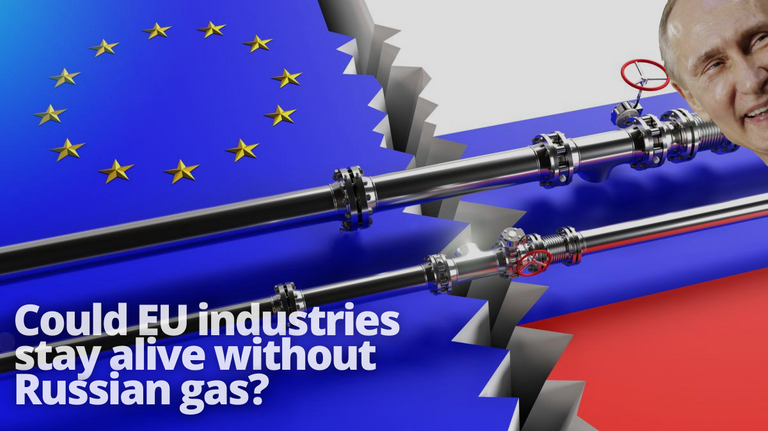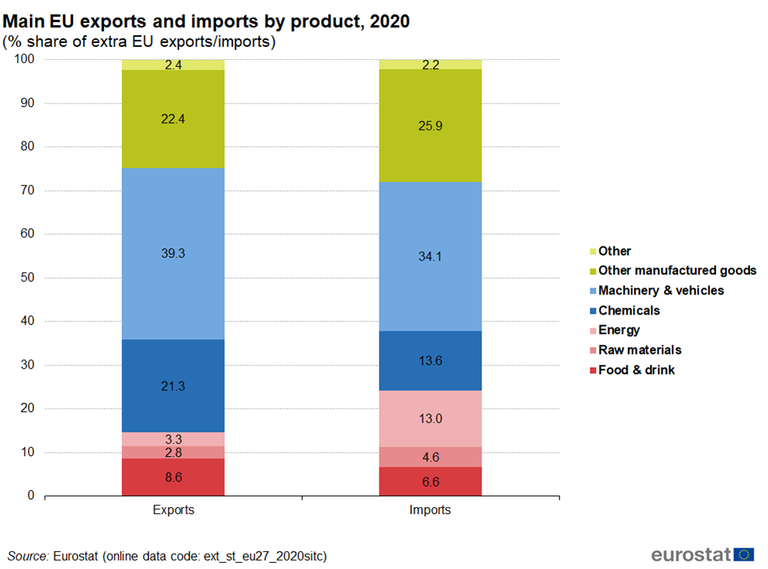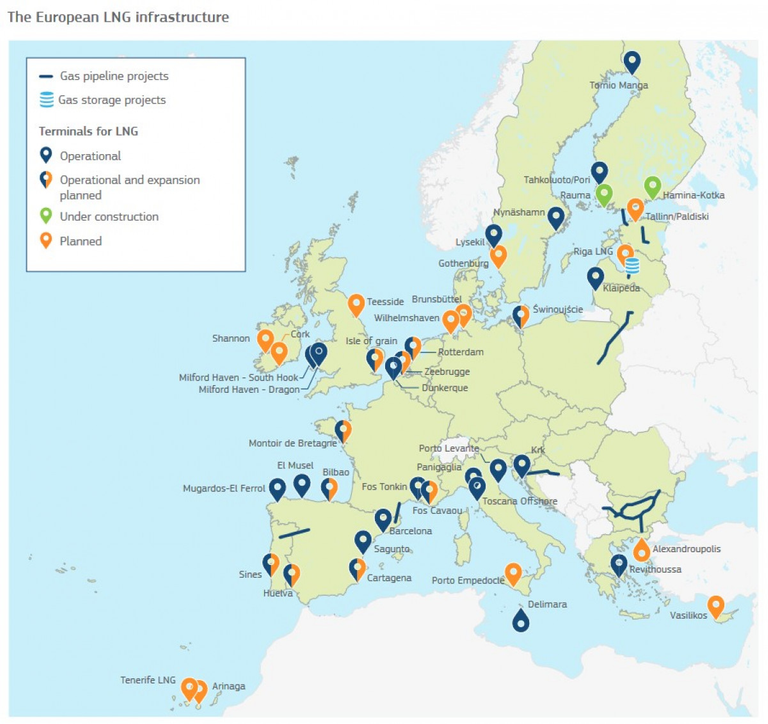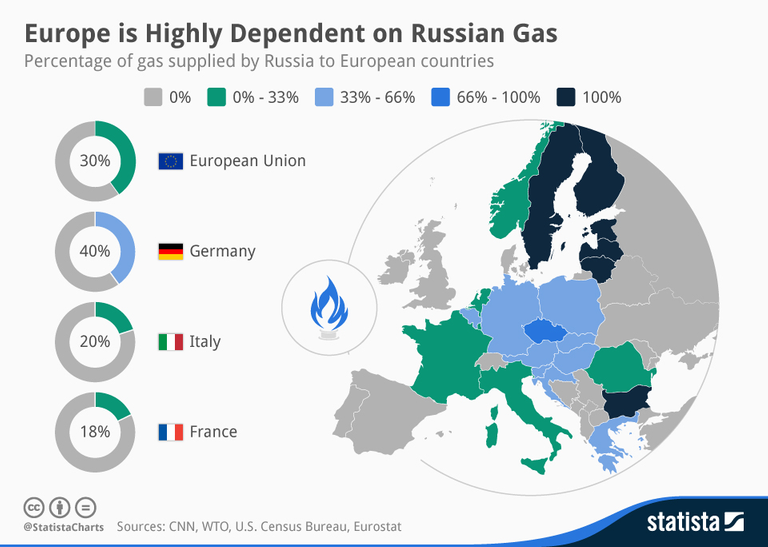
A steel mill in Germany, one in Poland and another one in Spain. and a fertilizer factory in Italy. All these different plants have reduced their production or been switched off because of high energy prices that have quintupled in the past year, in part due to the invasion of Ukraine. It raises questions about the ability of Europe's industry to stay afloat and have a functioning business case. And with European sanctions and Russia throttling exports, Europe is decoupling from Russia at a breakneck speed. It's something that risks compromising Europe's place in the global economy. So can Europe's economy exist without Russia?
Let's first start by looking at the European Union and how it functions in the global economy. Its main imports are raw commodities like petroleum products and minerals, as well as the manufacture of goods like computers. On the other hand, it exports high value added products, like in the automotive sector, the chemical and pharmaceutical industry and precision machinery. These sectors happen to be some of the most energy intensive and raw materials dependent economic sectors there are for the chemical industry. Energy prices made up to 20% of the cost of the final product in 2020. And the automotive industry is one of the biggest users of steel, for which production is also closely linked to energy prices. Meaning that Europe's most important industries are heavily dependent on accessible and cheap energy.

And that's where Russia came in, providing 25% of Europe's oil. 46% of its coal and 40% of its natural gas imports. This dependency is particularly great for Central and Eastern Europe, which are almost entirely dependent on Russian gas, despite the geopolitical problems opposed. This approach made sense from both an economic and sustainability perspective. So much so that several EU countries, particularly Germany and Italy, based their entire industrial strategy for the coming decades regarding the European Green Deal on the premise of cheap natural gas coming from Russia. But with the Russian invasion of Ukraine, these imports have been weaponized by both the West, which through sanctions, aims to deprive Russia of a key source of government income, and Russia, which wants to bring the West to the negotiating table as part of the sanctions.
Europe is set to phase out Russian coal from August 2020 onwards and most of its oil imports by the end of 2022. These resources, which can be replaced with relative ease, provide Russia with most of its income from energy imports. But natural gas, for which Europe has no direct alternatives, was exempted until Russia started limiting and cutting off Europe supply. So what does this mean for Europe? Well, natural gas is used primarily for heating homes, powering industry and electricity generation. And if we relate that to where the gas is coming from, we can see that there. The numbers don't add up with Russia progressively turning off the flow of gas. Europe is dipping into its storage reserves at a time where it should be filling them in anticipation for the winter. This is forcing European countries to balance a difficult equation.

LNG stations in eu
According to the International Energy Agency, it would be possible to cut this dependency by up to a third on the short term. Europe is turning coal and perhaps even nuclear reactors back on to shift natural gas away from power generation to other uses. It's also importing as much liquid natural gas as it can with imports from the United States having quintupled. And the EU's repower initiative is encouraging investments in energy efficiency ahead of this winter. If we add up these different measures out of the 140 billion cubic meters of gas imported from Russia, Europe could find alternatives for 63 billion cubic meters or 45% of the total. That means that even if Europe implements these measures and Russia cuts off Europe's gas entirely, it will lack approximately a quarter of the gas it needs for this year. This raises the prospects of shortages and energy rationing, which Russia wants to use as leverage to push Europe and therefore Ukraine to the negotiating table.
Europe will have to decide between heating its homes or powering its industry, and some European factories have already lowered production or switching it off entirely. Even if the war ends. It's unlikely that Europe will stop its decoupling from Russian energy imports. But this presents two major challenges in the medium term inadequate infrastructure and limited supply. On one hand, it just doesn't have enough liquid natural gas terminals. On the one hand, it just doesn't have enough liquid natural gas terminals, which can currently only cover 40% of the demand. And to make matters worse, pipelines which come from Russia get progressively smaller as they move further west, making it difficult to use liquid natural gas terminals to ship gas eastwards. To tackle this problem, European countries are building additional LNG terminals and new pipelines to improve connectivity across Europe. These will, however, take at least two years to build, meaning that until then, Europe will face a severe energy crunch.
Additionally, European countries have looked to buy natural gas from other countries like Qatar, Algeria, the US and European leaders have toward Africa striking deals to make up for the shortfall. But supply is limited, demand is growing and suppliers are afraid of overinvesting and because of the time it takes to develop new supply chains. Europe's energy scarcity will continue, which will limit investment growth and the ability of its factories to produce the chemicals and cars which its export industry is reliant on. Eventually, though, Europe will be able to phase out and replace Russian energy, but there likely to be some long term implications to the shift. Energy costs are likely to remain higher than they were because of low investment and a higher demand as the world shifts away from coal and in Europe. These costs will also increase because natural resources will have to be shipped from further away instead of arriving from the east. Energy imports will arrive from Europe south, which is closer to the North African and Middle Eastern gas fields and the West from the United States, which will turn into a major supplier for Europe.

Your pull in Europe, in effect, will be cut off from the cheap energy resources that it used to get from Russia. These long term trends will have several effects. One is the accelerated deployment of renewable energy and the doubling down on clean technology as a way to reduce Europe's energy dependency. But there's a catch that poses a risk to the future of Europe's business model. This drive for clean technology was supposed to start with natural gas. Green steel and green cement were initially supposed to rely on hydrogen produced by natural gas as a stepping stone. And because Europe is both specialized and the leader in energy intensive industries that are already operating with high energy prices, the new reality will only make the resources they currently use and those they need for the future more expensive. These industries could face pressure to move to places where energy is more abundant and cheaper, like the US, where energy prices are structurally lower. But that is a topic for another article.
Congratulations @scientify! You have completed the following achievement on the Hive blockchain and have been rewarded with new badge(s):
Your next target is to reach 100 upvotes.
You can view your badges on your board and compare yourself to others in the Ranking
If you no longer want to receive notifications, reply to this comment with the word
STOPTo support your work, I also upvoted your post!
Check out the last post from @hivebuzz: